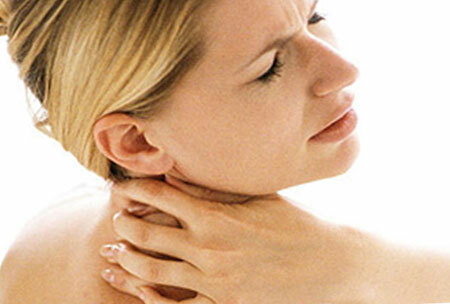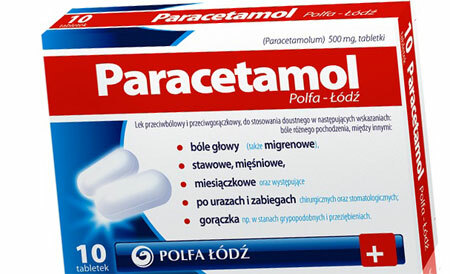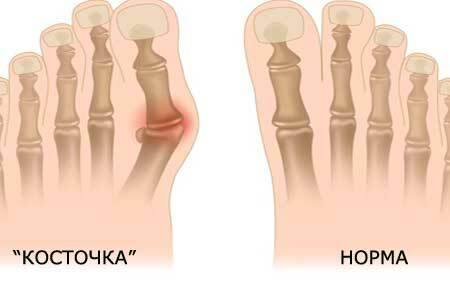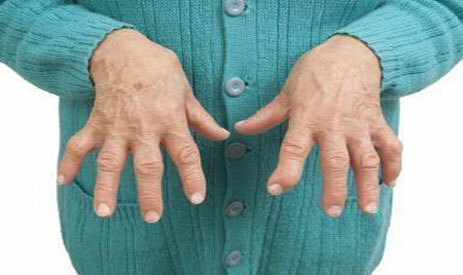The human spine is a complex and important anatomical structure of the body. Its features are a combination of bone-joint elements, spinal cord, nerves and vessels, united by complex relationships. However, it can function normally only in the absence of a pathological process in any of these components.
One of the main functions of the spinal column is movement( rotation, torso bends forward or backward, to the sides).In this case, the motor unit is the articulation of two adjacent vertebrae, consisting of the vertebrae, the intervertebral disk and the joints connecting the vertebrae.
The development of a pathological process in any of these elements adversely affects the entire system. And this leads to the development of osteochondrosis - a disease manifested by a decrease and a change in the quality of motor activity. At the same time, pain syndrome develops, which is the direct reason for contacting a doctor.
Contents
- 1 In what way is the osteochondrosis of the cervical spine expressed?
- 2 The cause of headaches in osteochondrosis
- 3 Types of pain in osteochondrosis of the cervical department
- 4 Treatment of headache with osteochondrosis of the cervical department
What is the expression of osteochondrosis of the cervical spine?

The essence of the original concept of "osteochondrosis" is the change in the intervertebral disc and surrounding bone tissue. The core of the disk undergoes degenerative changes - it loses its elasticity, dries and cracks. Further, pathological changes go to the fibrous ring surrounding the disc.
It can be shifted and fragmented( divided into functionally inferior parts), while sharp elements are formed. These disorders cause displacement of bones and cartilages, exert increased pressure, increase the load on the bone structures of the vertebrae and intervertebral joints.
As a result, there is a succession of stages reflecting the progression of the pathological process( osteochondrosis):
- deforming spondylosis - the appearance of bony outgrowths( beaks, thorns, mustaches - they got their name from the characteristic appearance);
- cartilaginous node - protrusion( hernia) of the disc through destruction in the fibrous ring( this is the stage of the intervertebral hernia);
- spondylarthrosis - "looseness" in the joints connecting the vertebrae, leading to displacement of the vertebrae relative to each other. At this stage, there is a great chance of developing serious compression complications, consisting in the consequences of compression of the spinal cord.
The combination of varying degrees of all these changes and pathological processes leads to the appearance of a characteristic clinical symptomatology of osteochondrosis - a typical pain syndrome, mobility disorders in the spine and muscle strains( the so-called "reins" sign, defined along the spinous processes of the vertebrae).
Cause of headaches with osteochondrosis
In cervical osteochondrosis, headaches are a characteristic clinical symptom within the pain syndrome. Their occurrence is explained by two basic mechanisms:
1. Reflex mechanism. This is a kind of "cry for help" from the affected elements of the spine. Due to pathological changes, there is irritation of the small nerves located inside the spinal column. These are the nerve endings of Lyushka. They transmit excessively increased impulse over the reflex arc to the brain. So there is a sense of pain localized in the head.
Some researchers identify another cause, in which the reflex mechanism of the occurrence of a headache is myofascial dysfunction. It consists in the pathological changes that occur with osteochondrosis in the neck muscles.
Muscular disorders are manifested by local spasm and dysfunction. These changes cause similar pathological impulses going to the brain, leading to the appearance of distant( headache) pain.
2. Compression mechanism. In this case, the appearance of cephalic pain is due to the mechanical effect of pathologically altered structures on the spinal cord and vessels. Thus, the formation of protrusions of the disc and bony outgrowths on the vertebrae, subluxation of the joint between them, lead to compression of the vertebral artery and the nerve plexus located around it.
As a result, there is a decrease in the intra-arterial lumen, which adversely affects the blood circulation of the brain. He begins to experience a state of hypoxia, turning into ischemia.
In this case, the level of lactic acid rises in the tissues, which irritates the nerve pain( algic) endings. Clinically, this is expressed in the form of a headache.
Another manifestation of the compression syndrome, which leads to the appearance of pain in the parietal-occipital region with osteochondrosis, is the compression of the spinal roots of the spinal nerves( radiculopathy).
A pathological mechanism is observed if the compression affects the roots connected to the second cervical vertebra. However, in practice this is rare.
Types of pain in osteochondrosis of the cervical department
 1. According to the origin of , the headache as a manifestation of osteochondrosis may be secondary or vertebrogenic. Secondary pain is explained by the fact that its occurrence is not associated with a pathological process directly localized in the head. It arises as a reaction to a process that takes place in another part of the body.
1. According to the origin of , the headache as a manifestation of osteochondrosis may be secondary or vertebrogenic. Secondary pain is explained by the fact that its occurrence is not associated with a pathological process directly localized in the head. It arises as a reaction to a process that takes place in another part of the body.
The term "vertebrogenic" means that the pathological process leading to pain occurs in the spine. In more detail this type of pain can be described as cervicogenic, which emphasizes its localization directly in the cervical spine.
2. The mechanism of occurrence of is a headache reflex. This suggests that it is due to the reflex mechanism - cervicocranium. Its appearance usually occurs between 40 and 60 years. This kind of pain is observed in 17% of the population.
Its clinical characteristics are:
- pain unilateral;
- character blunt drilling;
- begins with the neck area, moves to the nape with further spread to the forehead and whiskey;
- intensity is moderate, moderate( it is rarely very pronounced, so patients visit the doctor with delay, taking various pain medications);
- can be seizure;
- duration - several hours, if paroxysmal, it can last up to several days.
In some cases, cervicocranygia may be accompanied by additional symptoms:
- hypersensitivity to sounds( phonophobia) and to light( photophobia);
- is stuffy in the ears;
- with nausea, vomiting;
- by dilating the blood vessels of the eye proteins( red eyes);
- visual impairment in the form of a veil;
- straining the muscles of the neck;
- neck pain associated with muscle spasm;
- restriction of movement in the cervical region( stiffness).
In the diagnostic plan, pressure on the near-vertebral points helps. They correspond to the places of the exit of the nerve roots from the vertebral canal. Mechanical pressure on them can provoke a headache attack, which the patient can learn as "his".In this case, the cause-effect relationship of pain and cervical osteochondrosis becomes obvious.
Reflexive cervical craniatalgia may also be accompanied by pain that is transmitted to the shoulder and arm( cervicobrahialgia).This brings it closer to myocardial infarction, which must necessarily be differentiated. An electrocardiography helps to establish an accurate diagnosis at the time of a pain attack. With osteochondrosis, it does not reveal ischemic damage to the myocardium.
Sometimes, osteochondrosis is accompanied by migraine and primary headache( tension pain).In the case of a headache associated with myofascial syndrome, there will be a connection between the occurrence of unpleasant sensations in the head with simultaneous stiffness of the neck muscles and a significant limitation of movements in the neck. Vibration and pressure on the affected muscles can trigger an attack of characteristic cephalalgia.
To identify the pain associated with compression of the vertebral artery( it is called cervical migraine), the reference diagnostic criteria help:
- most often there is a one-sided pain;
- begins at the back of the head, then moves forward to the temple, parietal area. The painful "front" in the region of the superciliary arches ends. Such a spread of nerve impulses is called a "helmet symptom";
- is strengthened when moving in the cervical region, becausein this case, the compression on the vertebral artery increases;
- intensity is strong;
- character is pulsating, burning.
Pain of this species may be accompanied by:
- chills;
- with nausea, vomiting;
- by changing the pressure( rising or falling);
- by dizziness;
- with a heartbeat and death fear;
- with pain in the eyes, sensation of sand;
- by dilating the pupils on one side;
- facial swelling;
- impaired visual function in the form of fog;
- on the side of compression is characterized by tinnitus.
If a patient with mechanical compression of the vertebral artery presses on a point located near the mastoid process( bone protrusion of the skull behind the lower edge of the ear), then it is possible to provoke an attack of a headache of this type. Such a criterion makes it possible to determine the mechanism of the development of craniocephalgia without additional methods of investigation. Compression of the vertebral artery is often accompanied by pain in the shoulder and arm.
3. With the , the headache is classified into:
- episodic - pain worries up to 15 days per month( no more);
- chronic - precedents are observed more often( more than 15 days for a month).
Treatment of headache in cervical osteochondrosis

Given that headaches for osteochondrosis are only the "top" of the pathological process, treatment should cover the entire range of disorders occurring in this disease, and also take into account the cause and mechanism of the formation of the pain syndrome.
The main cures for headache in cervical osteochondrosis are selected taking into account the therapeutic direction. And it includes:
- anesthesia;
- elimination of muscle tension;
- improved biomechanics of the spine.
Anesthesia( analgesia) is the main stage of treatment, which allows to normalize a person's condition and improve his state of health. The main analgesic medicinal forms of drugs used in the treatment of headaches in osteochondrosis of the cervical region are tablets, capsules, and in severe cases, injections and neurological blockades.
The latter refer to specific procedures that must be performed only by a specialist trained in this direction.
The most effective group are NSAIDs - non-steroidal anti-inflammatory drugs. They are used both to quickly alleviate the patient's suffering, and for long-term treatment. They suppress the activity of the inflammatory reaction, thereby suppressing the pain. Representatives of this group are such drugs as Diclofenac, Aertal( aceclofenac) and others.
Recently completed randomized studies have shown that non-steroids are second-line drugs in the treatment of pain syndrome in osteochondrosis.they more often than Paracetamol provoke the development of side effects.
Therefore, the preparation of the first line is currently considered Paracetamol. This sensational discovery has turned the notions of many neurologists about approaches to symptomatic treatment of osteochondrosis.
Fast relief and good effect have anelgeziruyuschie blockade with novocaine, lidocaine in the area of "trigger points"( when exposed to which can occur a characteristic attack of headache).The disadvantage of these procedures is the need for a daily visit to the neurologist for their production. Therefore, blockades are used only with a pronounced pain syndrome for rapid docking, then switching to taking tablets.
To remove muscular tension( the second therapeutic direction), muscle relaxants are used. These include Tolperisone( Midokalm), Tizanidina and others. Preparations of this group are selected individually depending on the tolerability and clinical effectiveness.
Improvement of the biomechanics of the spine is effected by non-drug methods of exposure:
- manual therapy;
- massage;
- exercise therapy;
- acupuncture.
This direction is basic, becausecan slow the progression of the pathological process. It is recommended to conduct several physiotherapy courses throughout the year.
In case the headaches are long and worry the patient for a long time, the risk of depression increases. For its correction, antidepressants and psychotherapy are used. Recently, there have been reports of the treatment of a chronic form of cervicogenic headache with botulinum toxin preparations. They are effective for pain associated with muscle spasms.
To prevent repeated pain attacks should be carried out pathogenetic treatment of osteochondrosis. It is aimed at eliminating the causal pathological process - the destruction of intervertebral discs. Tableted forms of chondroprotectors( glucosamine and chondroitin sulfate) effectively cope with this task.
With prolonged admission, the destructive process in the cartilaginous part of the disc stops, and the development of new structural fibers that help to repair damaged discs is stimulated.
Simultaneously with drug therapy, all patients should increase the activity of a lifestyle, engage in regular physical training, normalize the psycho-emotional background, reduce the amount of stress, and prevent trauma to the spine.



